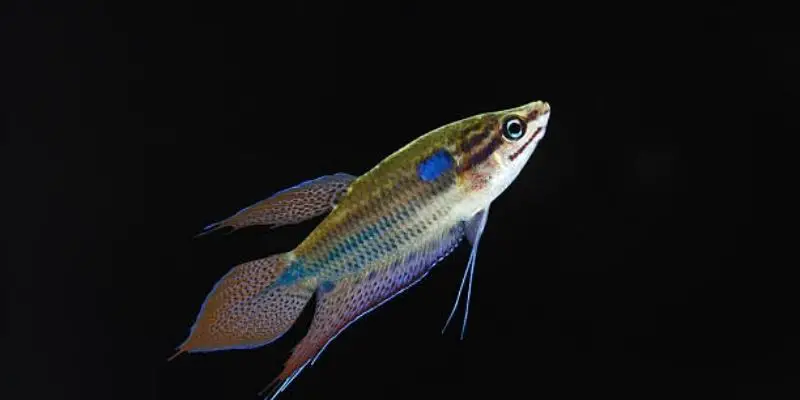Normally when we think of fish mating, we imagine two brightly colored tropical fish darting around in an aquarium. But the mating behavior of some fish is downright strange. Gouramis are one such species. In this blog post, we’ll take a look at how gouramis mate and what makes their mating behavior unique. Stay tuned!
The Gourami Fish:
Gouramis are a type of freshwater tropical fish. There are several different types of gourami, including flame gourami, butterfly gourami, and moonlight gourami. They’re beautiful fish with long fins that flow attractively as they swim.
The bright colors on their bodies also make them popular in the fishkeeping hobby, where they are sometimes sold under the name “pearl gourami.”
As their scientific name indicates, Colisa Lalia is native to Asia. This includes areas like India, Thailand, Malaysia and Indonesia. They prefer slow-moving waters with plenty of vegetation. Gouramis are also carnivorous, feeding mostly on small fish, worms, insects and insect larvae.
Male-Female Pairing
Gouramis are popular with aquarium owners because they can be easily bred in captivity. The female lays up to 400 eggs which the male then fertilizes through a process called spawning. After hatching, this spawns is complete and it’s time for the parents to start over again.
But their spawning is a bit more involved than other species’ mating rituals. In fact, they actually get into some pretty strange mating behaviors before fertilizing their eggs.
Queue The Mating Dance
Male gouramis have some unique breeding traits that make them stand out from most fish species. Like many other fish, the males are generally bigger in size than females. They also have what’s called a nuptial pad on their heads. This is used to grip onto the female during mating in order to impregnate her.
But there’s something more!
Before he can get down to business, the male gourami starts a special dance to catch the female’s attention. He starts by circling around her, changing colors as he goes. This is accompanied by a sharp rapid movement of his body towards and away from the female. When she has had enough of his advances, she stops him with another dance of her own!
And this may go on for some time until, finally, the male is allowed to get close enough for a few seconds to fertilize the eggs. The female will produce around 400-500 eggs, all fertilized in less than a minute.
Then the female is chased away. The male gourami will not eat for up to a week after spawning, which means he must be careful not to fall prey to predators during that time.
After around 2 days the eggs will hatch into tiny fish known as fry. As they are born without functional digestive systems, they have no need for a father and the male is free to mate again.
And this is how gouramis make a baby!
What Do Gourami Eggs Look Like?
The tiny eggs laid by female gouramis are transparent and they attach themselves to the leaves in the water. Once fertilized, they become orange or pink and swell slightly in size.
If you look closely at the eggs during the early stages of development, you can see a small black spot in their center. This is actually where the fish will start out life as an embryo.
As they develop, the embryos begin to absorb nutrients from their surroundings. You’ll also see two eyes appearing inside each egg that eventually become very visible. The small black spot will eventually develop into the fish’s mouth.
While these are fascinating to look at, you should avoid disturbing them if possible. This is to help keep the water quality high and reduce stress on the fish.
Gourami babies are very small when they hatch so it’s very important not to overcrowd your aquarium with too many fry. You should also make sure there are plenty of hiding spots for the little guys.
If you plan on continuing with your gourami breeding, you will need to separate them from any bigger fish immediately. The small fry will be eaten by most tank inhabitants including adult gouramis!
How Long Are Gourami Fish Pregnant For?
Gouramis are pregnant for a little over a month, the female laying her eggs during this time. The fry will hatch after two or three days and they’ll be ready to take on the world after a couple more weeks.
If you remove the eggs, they’ll usually be ready to hatch in another two weeks. Just make sure you leave them with the male until after they’ve hatched or he might eat his babies!
How Often Do Gouramis Breed?
Gouramis are known for their consistent mating behaviors and they breed year round. This is pretty convenient considering that they can produce hundreds of fry in a short time!
All About Gourami Fish Mating and Breeding
Mating and breeding behavior is not something we get to see very often in aquarium fish, but it’s actually really interesting. You can tell a lot about your fish by how they interact with each other and their surroundings so it’s important to pay attention.
As you may have guessed from the previous section, gouramis breed quite often as long as there are fertile males and females in the tank. In order for mating to take place, the female needs to be healthy and the male must feel like he has a chance.
You can encourage mating in your tank by feeding them well, keeping the water clean and making sure they’re not too crowded. Make sure you have at least one female for every two males or else there may be some fighting that goes on when she’s ready to mate!
What Do Gourami Fish Look Like Before They Mate?
You may have noticed that these fish can change color depending on their mood. Now this usually happens very quickly, but when they’re ready to mate the changes are a lot more obvious!
When mating is imminent, males become much more colorful and they also develop a white spot on their head. The female will have a similar spot, but it’s less noticeable.
Sometimes the male will even turn completely black or blue to indicate that he’s ready for action. You’ll know when they’re feeling frisky as they begin swimming back and forth with their noses pointed up in the air.
Conclusion:
I hope this article has given you the know-how to breed, feed and care for your baby gourami fish. If you’ve never kept these tropical beauties before, they can be a little difficult to keep at first, but it’s all worth it in the end!
If you’re thinking about buying some gourami fish, I would suggest you read our article “Gourami Fish Care: How To Keep Them” first.

